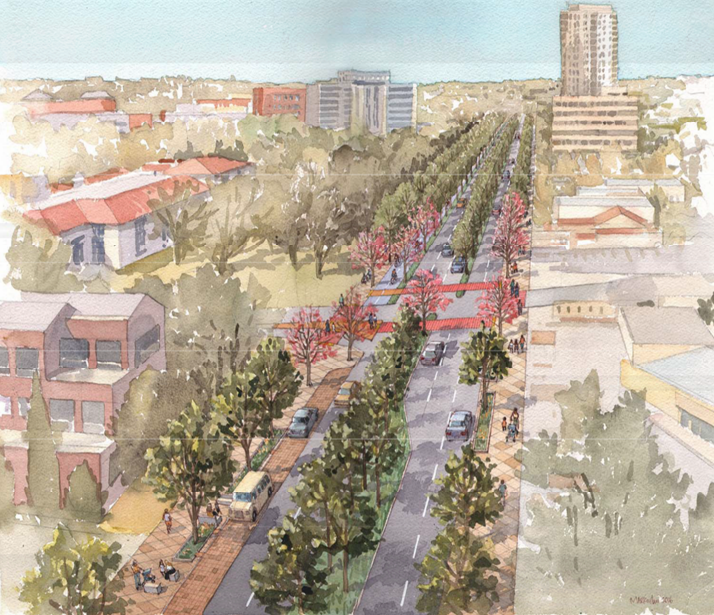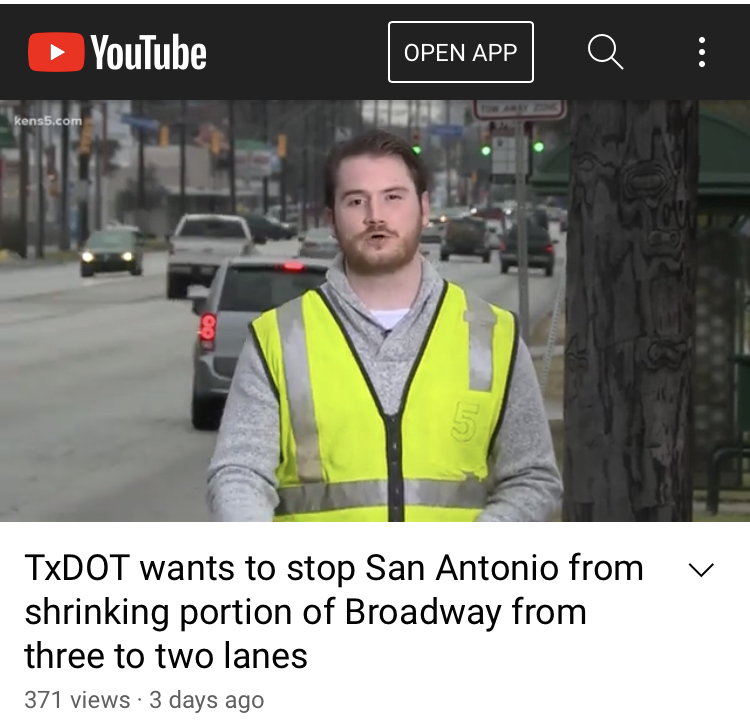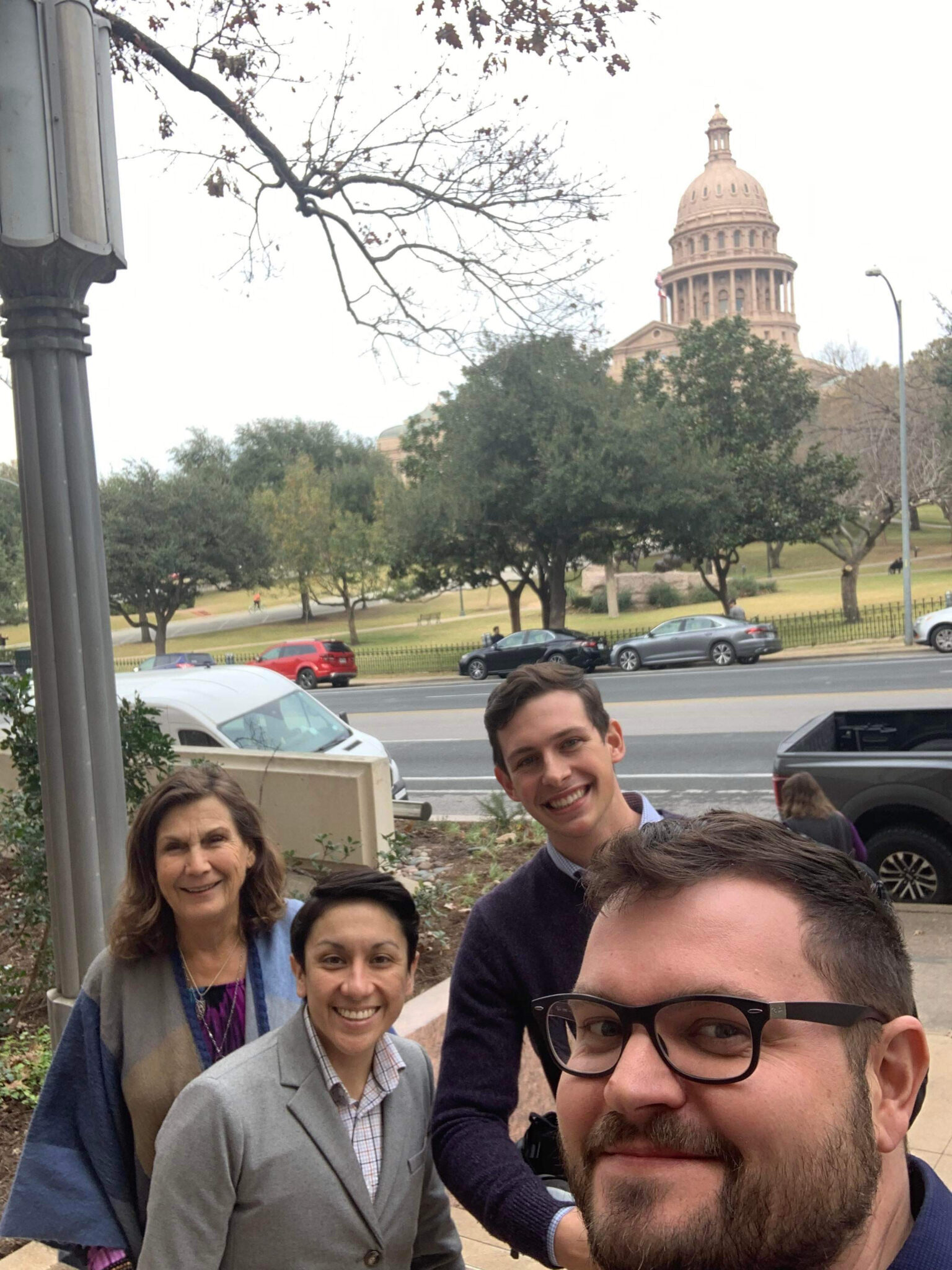
Late this month, the Texas Department of Transportation announced that it will rescind minute orders issued in 2014 and 2015 transferring control of Broadway Street along the 2.2-mile stretch from I-35 to Burr Road to the City of San Antonio.
For the past six years, the City has been busy planning and implementing multiple phases of the Broadway Corridor Project, beginning with Phase 1: the Lower Segment, which encompasses Broadway from East Houston Street to the I-35 overpass–a $43 street redevelopment plan funded by voters.
A major component is a road diet—a reduction in the number of north and southbound traveling lanes from three to two on both sides of Upper Broadway Street–to make room for a protected bike lane, wider sidewalks, and shade trees for cyclists and pedestrians.
Shortly after receiving word of this decision from members of the San Antonio Cycling Coalition, Bike San Antonio traveled to Austin to attend a meeting hosted by the Texas Transportation Commission. We also submitted public comments to the Texas Governor’s Office and gave interviews to local media to voice support for the City’s original plan to build bike lanes on Broadway. 
TxDOT’s rationale for the motion to retake Broadway was that a lane reduction would increase congestion and drive cars from Broadway to 281.
The news came as a huge shock to San Antonio cyclists, but it’s a setback for the whole city, which has been making headway in recent years to becoming more bike-friendly. City leaders, including Mayor Ron Nirenberg, voiced their opposition on social media and public forums.
“We need public outrage about this,” said Bryan Martin, former interim executive director of Bike SA. “This is the exact opposite of small government. TxDOT should trust San Antonians to make decisions that are right for them and their community.
“These roads need to go on a diet, and make it safer for pedestrians, bus riders, and cyclists,” he added. “What I’m hearing from TxDOT is a 1 to 2-minute delay is not worth saving lives.”
“Having streets like Broadway under local control allows cities to better attune streets and zoning according to the needs of everyone who uses it,” said Bike SA Board Member Alvin Holbrook. “Forcibly taking control from the city does just the opposite, leaving it to a highway-obsessed firm with a track record of putting auto traffic before people. If you care about how your city looks and feels, you need to care about this.”
Read a letter from SA business and civic leaders to the Transportation Department
Streets like Broadway that are not major highways belong under local control. The posted speed limit on Broadway is 35 miles per hour. Businesses and drive-outs line both sides, buses frequent the right lane, and it is flanked by residential neighborhoods to the east and west, as well as Brackenridge Park. Turning it into a highway will increase the Level of Traffic Stress (LTS) that a person on a bike feels riding close to cars, buses, and other traffic.
Research from the Alamo Area Metropolitan Planning Organization shows that while most people are comfortable riding on a quiet residential street, they would feel unsafe riding on a six-lane road with a 40-mile-per-hour speed limit. Most people avoid riding a bike on many parts of San Antonio’s street network because it is a stressful experience.
Since I began biking nine years ago, I’ve ridden on Broadway many times and have never felt safe. Several years ago, I was sideswiped by a truck driver in Alamo Heights who was trying to cut across a neighborhood street over to Broadway. A pedestrian witnessed the near-crash and said it behooved me to watch out for certain motorists, because they could behave aggressively. I’ll never forget his words or the jarring experience, and how I felt like I’d avoided death.
I wonder what the driver would have said if I’d confronted him. I didn’t see her. The sun was in my eyes. I was in a hurry. All of these are reasons I’ve heard motorists give to try and explain bike crashes. None rationalize the damage done to cyclists by motor vehicles each year on Texas roadways.

Roadway crashes continue to rise in our state. More than 4,400 people were killed on Texas roadways last year–the second-highest count for the state roads ever, and 500 more than were recorded in 2020, according to data from the Texas Transportation Commission. Crashes involving pedestrians and cyclist fatalities and serious injuries were higher in 2021 than they have been in years.
That’s why cyclists follow Texas bike laws when riding on public roads, whether they’re quaint side streets, busy thoroughfares, or access roads. We know we have the same rights and responsibilities as drivers, and that it’s important to signal properly when turning and coming to full stops at Stop signs and red lights. Even on the greenways, which prohibits motor vehicle traffic, we practice etiquette to keep the linear spaces a safe, fun, and recreational place for all.
We appreciate it when drivers move over and #Give3Feet of space for us to ride on major/busy roadways. It makes us feel not only safer, but like we’re part of a community.
As the implications of this latest development roll out, we anticipate hearing how federal transportation dollars allocated to the Broadway project will be spent. We are encouraged by measures taken at the federal level, from a new safety policy outlined by U.S. Secretary of Transportation Pete Buttigieg aimed at setting better guidance for setting safe speed limits and also awarding grants to cities that build Complete Streets. The new infrastructure bill will provide federal grants to improve bike and pedestrian facilities in safety in our town, as well as roadway issues across the state.
We hope TxDOT keeps the City’s plans for Broadway and recognizes that multimodal transportation isn’t just about urban design for a select group of people, but building the framework for modern and innovative cities across Texas.
-Katie Nickas
Secretary of Bike San Antonio
I absolutely hate the big government philosophy Texas has been embracing to keep ‘liberal cities’ under their thumb. Even with as much as we’ve done in the last decade to increase biking spaces in the city, San Antonio is still not a bike friendly place for so many people. I have to ride four miles to get to my closest greenway, and I can’t get anywhere near downtown without navigating some pretty sketchy streets. I hate to hear that Texas is actively hindering the needed changes that would give bikes a place to safely ride.